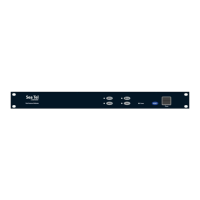
Do you have a question about the COBHAM Sea Tel Dual Antenna Arbitrator and is the answer not in the manual?
| Category | Marine Equipment |
|---|---|
| Manufacturer | COBHAM |
| Model | Sea Tel Dual Antenna Arbitrator |
| Stabilization | Yes |
| Environmental Rating | Marine |
Explains how to configure the system for dual antenna operation to provide uninterrupted services.
Describes the function and signal flow of the Dual Antenna Arbitrator panel, including LNB voltage and signal passing.
Details the method for remotely reconfiguring ACUs to use different beams or satellites.
Explains the standardized language for automatic beam switching between modems and ACUs.
Covers FCC regulations for ESV antennas and the 'Transmit Mute' requirement for pointing accuracy.
Details the function of each button on the Dual Antenna Arbitrator's front panel for mode selection and resets.
Explains the meaning of each LED indicator on the front panel for antenna status and mode.
Describes the automatic switching mode where the arbitrator uses ACU inputs for antenna selection.
Explains how to manually select an active antenna and switch between antennas as needed.
Lists basic commands and responses for controlling Automatic Beam Switching.
Details the OpenAMIP protocol for modem-ACU communication and automatic beam switching.
Specifies hardware and software requirements for OpenAMIP compatibility.
Lists commands for direct communication with the Dual Antenna Arbitrator for configuration and status.
Provides detailed explanations for various Arbitrator commands, including system settings and antenna control.
Explains command syntax, case insensitivity, and character handling for successful command entry.
Instructions for carefully unpacking and inspecting the Dual Antenna Arbitrator for damage.
Guidance on physically installing the arbitrator in a 19-inch equipment rack near other components.
Cautionary advice for routing and installing shipboard cables to prevent damage.
Details physical connections for power, LNB, TX, BUC, and data interfaces to the arbitrator.
Steps for configuring IP addresses, tracking, targeting, and blockage zones for optimal performance.
Procedure for setting IP addresses for MXP A, MXP B, and the Arbitrator.
Instructions to refer to the antenna manual for optimizing tracking and targeting settings.
Instructions to refer to the antenna manual for entering blockage zone data.
Guidance on balancing RF performance (TX & RX) between antennas for seamless switching.
Lists default configuration parameters for the Arbitrator and MXPs for network or LAN conformity.
Detailed steps for balancing TX/RX outputs, including cross-pol optimization and compression tests.
Procedure to test the arbitrator's switching functionality in manual mode with modem lock verification.
Guidance on tracing IF/RF signal paths and using a spectrum analyzer for testing issues.
Troubleshooting steps for GPS signal updating and continuity issues with MXPs and modem.
Steps to diagnose issues with network lock signal transmission and reception between components.
Troubleshooting TX Mute functionality to ensure compliance with FCC requirements.
Instructions for assembling the outer slide rails for rack mounting.
Steps to install the outer slide rails into the equipment rack.
Instructions for attaching the inner slide rails to the Arbitrator unit.
Provides physical dimensions, input voltage, power requirements, and weight.
Details the status indicator display, buttons, and controls on the front panel.
Lists the connectors available on the rear panel of the arbitrator.
Describes connections on the standard low power rear panel switch plate.
Details connections on the rear panel switch plate for the 10 MHz option.
Details connections on the rear panel switch plate for the high power option.
Lists EMC and Safety compliance standards (EN60945, EN60950).
Specifies operating temperature and humidity requirements for the equipment.
Lists available drawings for the Dual Antenna Arbitrator and its accessories.
